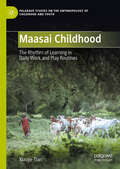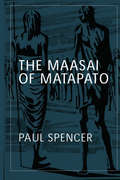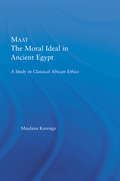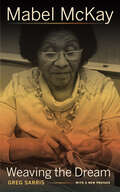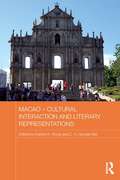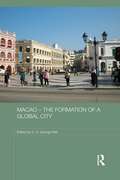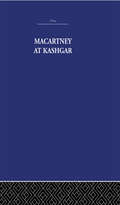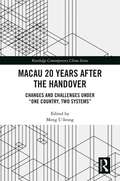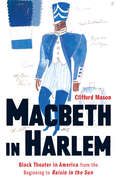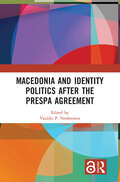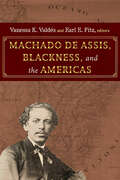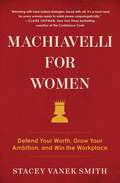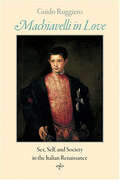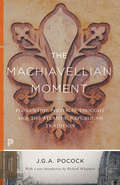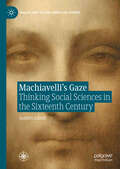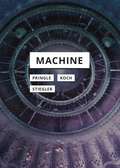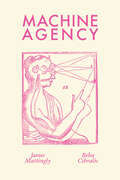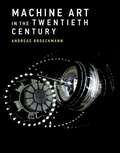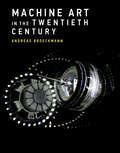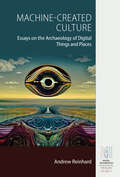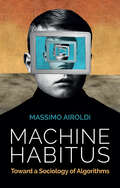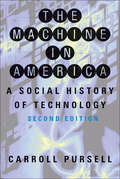- Table View
- List View
Maasai Childhood: The Rhythm of Learning in Daily Work and Play Routines (Palgrave Studies on the Anthropology of Childhood and Youth)
by Xiaojie TianThis book aims to provide comprehensive ethnographic documentation of pastoralist childhood and child learning, based on the author’s long-term fieldwork in pastoralist Maasai society in southern Kenya. It conveys a timely account of the developmental niche in contemporary Maasai society, in children’s lives, social roles, work, play, and learning in family routines. Pastoralism is an important livelihood system that has allowed humans to live in arid and semi-arid lands for centuries. Children in pastoralist societies are expected to, and indeed do, actively and independently participate in and contribute to local subsistence from an early age. Compared to studies of other forms of livelihood, anthropological investigations into pastoralist children remain limited, particularly in light of critical social changes pastoralists have undergone in the last three decades. Less is known about their local parenting ethnotheories, childhood play, and children’s practices of self-reliance in making positive changes in their families and local communities. Having a better understanding of pastoral childhood in concurrent natural and social complexities is vital for further investigation of human development in general and the pastoralist culture in particular.
The Maasai of Matapato: A Study of Rituals of Rebellion (Routledge Classic Ethnographies)
by Paul SpencerWhen first published in 1988, this classic study was the first to relate the dynamics of the Maasai age organisation to the tensions within the family. Together, these provide the twin strands of a man's career, opposed ritually and reflecting a fundamental ambivalence in Maasai thought. The analysis is illustrated with extensive case material from the the Matapato, selected for this study as a typical Maasai group.
Maat, The Moral Ideal in Ancient Egypt: A Study in Classical African Ethics (African Studies)
by Maulana KarengaFirst published in 2004. Routledge is an imprint of Taylor & Francis, an informa company.
Mabel McKay: Weaving the Dream
by Greg SarrisA world-renowned Pomo basket weaver and medicine woman, Mabel McKay expressed her genius through her celebrated baskets, her Dreams, her cures, and the stories with which she kept her culture alive. She spent her life teaching others how the spirit speaks through the Dream, how the spirit heals, and how the spirit demands to be heard.Greg Sarris weaves together stories from Mabel McKay's life with an account of how he tried, and she resisted, telling her story straight—the white people's way. Sarris, an Indian of mixed-blood heritage, finds his own story in his search for Mabel McKay's. Beautifully narrated, Weaving the Dream initiates the reader into Pomo culture and demonstrates how a woman who worked most of her life in a cannery could become a great healer and an artist whose baskets were collected by the Smithsonian.Hearing Mabel McKay's life story, we see that distinctions between material and spiritual and between mundane and magical disappear. What remains is a timeless way of healing, of making art, and of being in the world. Sarris’s new preface, written expressly for this edition, meditates on Mabel McKay’s enduring legacy and the continued importance of her teachings.
Macao - Cultural Interaction and Literary Representations (Routledge Studies in the Modern History of Asia)
by Katrine K. Wong C. X. George WeiMacao, the former Portuguese colony in southeast China from the 1550s until its return to China in 1999, has a long and very interesting history of cultural interaction between China and the West. As an entity with independent political power and a unique social setting and cultural development, the identity of Macao’s people is not only indicative of the legacy and influence of the region’s socio-historical factors and forces, but it has also been altered, transformed and maintained because of the input, action, interaction and stimulation of creative arts and literatures. Held together by racial accommodation and tolerance and active cultural interactions, Macao’s phenomenon can be characterized as hybridization. This book is a presentation of the ongoing hybridization of Macao and is in itself a hybrid, covering a wide range of issues. Putting forward substantial new research findings, the book explores the nature of cultural interaction in Macao, and how the city has been constructed and perceived through literature and other art forms. It is a companion volume to Macao – The Formation of a Global City .
Macao - The Formation of a Global City (Routledge Studies in the Modern History of Asia)
by C. X. George WeiMacao, the former Portuguese colony in southeast China, has a long and very interesting history of cultural interaction between China and the West. Held by the Portuguese from the 1550s until its return to China in 1999, Macao was up to the emergence of Hong Kong in the later nineteenth century the principal point of entry into China for all Westerners - Dutch, British and others, as well as Portuguese. The relatively relaxed nature of Portuguese colonial rule, intermarriage, the mixing of Chinese and Western cultures, and the fact that Macao served as a safe haven for many Chinese reformers at odds with the Chinese authorities, including Sun Yat-sen, all combined to make Macao a very different and special place. This book explores how Macao was formed over the centuries. It puts forward substantial new research findings and new thinking, and covers a wide range of issues. It is a companion volume to Macao - Cultural Interaction and Literary Representations.
The Macaque Connection
by Anindya Sinha Michael A. Huffman Sindhu RadhakrishnaThe concept of this book arises from a symposium entitled "Human-Macaque Interactions: Traditional and Modern Perspectives on Cooperation and Conflict " organized at the 23rd Congress of the International Primatological Society, that was held in Kyoto in September 2010. The symposium highlighted the many aspects of human-macaque relations and some of the participants were invited to contribute to this volume. The volume will include about 11 chapters by a variety of international authors and some excerpts from published literature that illustrate cultural notions of macaques. Contributions from invited authors will engage with four main perspectives - traditional views of macaques, cooperative relationships between humans and macaques, current scenarios of human-macaque conflict, and how living with and beside humans has affected macaques. Authors will address these concerns through their research findings and reviews of their work on the Asian, and the lone African, macaques.
Macartney at Kashgar: New Light on British, Chinese and Russian Activities in Sinkiang, 1890-1918
by Pamela Nightingale C.P. SkrineFirst published in 1973. This book describes the career of Sir George Macartney, who spent twenty-eight years at the turn of the nineteenth century as British representative in Sinkiang, China's most westerly province. Macartney was in a unique position to observe political and diplomatic manoeuvres by the key players trying to establish a sphere of influence in China's strategically vital hinterland before and during the Chinese revolution.
Macau 20 Years after the Handover: Changes and Challenges under “One Country, Two Systems” (Routledge Contemporary China Series)
by Meng U IeongThis book outlines the major social and political changes in the city of Macau during its first 20 years under the "One Country, Two Systems" arrangement with Mainland China.Despite the long-standing image of Macau as Asia’s Las Vegas, it is a city that has changed a great deal since its return to China. Equally, despite this return, it retains a unique social, economic and political character, distinct both from the Mainland of China and from its larger neighbour, Hong Kong. The chapters in this book examine the detail of this uniqueness from a range of perspectives, including the gambling industry, police-society relations, media usage patterns and protest movements. Analysing the state of affairs 20 years after the city’s return to China, they also attempt to anticipate its future trajectory.This is a valuable guide for scholars of Asian, and particularly Chinese, urban politics that will be of interest to academics and students looking to better understand the particularities of Macau.
Macbeth in Harlem: Black Theater in America from the Beginning to Raisin in the Sun
by Clifford MasonIn 1936 Orson Welles directed a celebrated all-black production of Macbeth that was hailed as a breakthrough for African Americans in the theater. For over a century, black performers had fought for the right to perform on the American stage, going all the way back to an 1820s Shakespearean troupe that performed Richard III, Othello, and Macbeth, without relying on white patronage. "Macbeth" in Harlem tells the story of these actors and their fellow black theatrical artists, from the early nineteenth century to the dawn of the civil rights era. For the first time we see how African American performers fought to carve out a space for authentic black voices onstage, at a time when blockbuster plays like Uncle Tom’s Cabin and The Octoroon trafficked in cheap stereotypes. Though the Harlem Renaissance brought an influx of talented black writers and directors to the forefront of the American stage, they still struggled to gain recognition from an indifferent critical press. Above all, "Macbeth" in Harlem is a testament to black artistry thriving in the face of adversity. It chronicles how even as the endemic racism in American society and its theatrical establishment forced black performers to abase themselves for white audiences’ amusement, African Americans overcame those obstacles to enrich the nation’s theater in countless ways.
Macedonia and Identity Politics After the Prespa Agreement
by Vasiliki P. NeofotistosThis book explores issues of national identity, history, and language in light of the 2018 Prespa Agreement. Designed to resolve a protracted and bitter dispute, the agreement signed by the Macedonian and Greek foreign ministers on the banks of the Prespa lake stipulated that the Republic of Macedonia change its name to the Republic of North Macedonia. The chapters examine the social, political, and economic conditions and events that led to the agreement and the implications and consequences for identity politics in the region. Consideration is given to the ways in which, and the reasons why, identity/identities, difference/differences, modes of belonging, and experiences of injustice and discrimination have been mobilized. By focusing on the Prespa Agreement, the collection also offers valuable insight into the processes involved in (re)making boundaries, (re)defining ethnic and national identities, (re)inventing citizenship, and (re)writing national histories. Bringing together expert contributors with intimate knowledge of, and long-term engagement with, the region, this volume will be of interest to scholars and students of anthropology, Slavic and East European studies, history, and international relations.
The Macedonian Conflict: Ethnic Nationalism in a Transnational World
by Loring M. DanforthGreeks and Macedonians are presently engaged in an often heated dispute involving competing claims to a single identity. Each group asserts that they, and they alone, have the right to identify themselves as Macedonians. The Greek government denies the existence of a Macedonian nation and insists that all Macedonians are Greeks, while Macedonians vehemently assert their existence as a unique people. Here Loring Danforth examines the Macedonian conflict in light of contemporary theoretical work on ethnic nationalism, the construction of national identities and cultures, the invention of tradition, and the role of the state in the process of building a nation. The conflict is set in the broader context of Balkan history and in the more narrow context of the recent disintegration of Yugoslavia. Danforth focuses on the transnational dimension of the "global cultural war" taking place between Greeks and Macedonians both in the Balkans and in the diaspora. He analyzes two issues in particular: the struggle for human rights of the Macedonian minority in northern Greece and the campaign for international recognition of the newly independent Republic of Macedonia. The book concludes with a detailed analysis of the construction of identity at an individual level among immigrants from northern Greece who have settled in Australia, where multiculturalism is an official policy. People from the same villages, members of the same families, living in the northern suburbs of Melbourne have adopted different national identities.
Machado de Assis, Blackness, and the Americas (SUNY series, Afro-Latinx Futures)
by Vanessa K. Valdés; Earl E. FitzConsidered a genius in his own lifetime, Joaquim Maria Machado de Assis (1839–1908) is Brazil's most canonized writer. Yet, he remains a contested and even enigmatic figure to readers in Brazil and abroad, his relative silence on slavery leaving him vulnerable to charges of aspirations to whiteness. Machado de Assis, Blackness, and the Americas reconsiders this issue by exploring how his prose fiction has been received in the United States. In seven original essays, contributors re-examine his novels and short stories, as well as photographs of the writer, in order to better understand the strategies he employed to navigate Brazil's literary scene as a man of African descent. Framed by a contextualizing introduction and an afterword in the form of a conversation between the editors, the volume speaks to and with our own historical moment and the realities of Black lives in the Americas over the course of the last two centuries.
Machiavelli for Women: Defend Your Worth, Grow Your Ambition, and Win the Workplace
by Stacey Vanek SmithFrom the NPR host of The Indicator and correspondent for Planet Money comes an &“accessible, funny, clear-eyed, and practical&” (Sarah Knight, New York Times bestselling author) guide for how women can apply the principles of 16th-century philosopher Niccolò Machiavelli to their work lives and finally shatter the glass ceiling—perfect for fans of Feminist Fight Club, Lean In, and Nice Girls Don&’t Get the Corner Office.Women have been making strides towards equality for decades, or so we&’re often told. They&’ve been increasingly entering male-dominated areas of the workforce and consistently surpassing their male peers in grades, university attendance, and degrees. They&’ve recently stormed the political arena with a vengeance. But despite all of this, the payoff is—quite literally—not there: the gender pay gap has held steady at about 20% since 2000. And the number of female CEOs for Fortune 500 companies has actually been declining. So why, in the age of #MeToo and #TimesUp, is the glass ceiling still holding strong? And how can we shatter it for once and for all? Stacy Vanek Smith&’s advice: ask Machiavelli &“with this delicious look at what we have to gain by examining our relationship to power&” (Sally Helgesen, New York Times bestselling author). Using The Prince as a guide and with charm and wit, Smith applies Renaissance politics to the 21st century, and demonstrates how women can take and maintain power in careers where they have long been cast as second-best. &“Machiavelli For Women is the ultimate battle guide for our times. Brimming with hard-boiled strategies, laced with wit, it&’s a must read for every woman ready to wield power unapologetically&” (Claire Shipman, coauthor of The Confidence Code).
Machiavelli in Love: Sex, Self, and Society in the Italian Renaissance
by Guido RuggieroA “provocative” study of sex and sexual identity in Renaissance Italy, explored through major literary works and historical archives (Choice).Machiavelli in Love introduces a complex concept of sex and sexual identity and their roles in the culture and politics of the Italian Renaissance. Guido Ruggiero’s study counters the consensus among historians and literary critics that there was little sense of individual identity and almost no sense of sexual identity before the modern period.Drawing from the works of major literary figures such as Boccaccio, Aretino, and Castiglione, and rereading them against archival evidence, Ruggiero examines the concept of identity via consensus realities of family, neighbors, friends, and social peers, as well as broader communities and solidarities. The author contends that Renaissance Italians understood sexual identity as a part of the human life cycle, something that changed throughout stages of youthful experimentation, marriage, adult companionship, and old age.Machiavelli’s letters and literary production reveal a fascinating construction of self that is highly reliant on sexual reputation. Ruggiero’s challenging reinterpretation of this canonical figure, as well as his unique treatment of other major works of the period, offer new approaches for reading Renaissance literature and new understandings of the way life was lived and perceived during this time.
The Machiavellian Moment: Florentine Political Thought and the Atlantic Republican Tradition
by J. G. Pocock Richard WhatmoreOriginally published in 1975, The Machiavellian Moment remains a landmark of historical and political thought. Celebrated historian J.G.A. Pocock looks at the consequences for modern historical and social consciousness arising from the ideal of the classical republic revived by Machiavelli and other thinkers of Renaissance Italy. Pocock shows that Machiavelli's prime emphasis was on the moment in which the republic confronts the problem of its own instability in time, which Pocock calls the "Machiavellian moment."After examining this problem in the works of Machiavelli, Guicciardini, and Giannotti, Pocock turns to the revival of republican ideology in Puritan England and in Revolutionary and Federalist America. He argues that the American Revolution can be considered the last great act of civic humanism of the Renaissance and he relates the origins of modern historicism to the clash between civic, Christian, and commercial values in eighteenth-century thought.This Princeton Classics edition of The Machiavellian Moment features a new introduction by Richard Whatmore.
Machiavelli’s Gaze: Thinking Social Sciences in the Sixteenth Century (Italian and Italian American Studies)
by Sandro LandiThis book examines Machiavelli in contemporary or past realities through the way in which he read, wrote, related to cultures distant in time and space—a first in the field of Machiavellian studies. It proposes and experiments with a change of perspective: in essence, it is not interested in what Machiavelli probably was, but in what Machiavelli did. In this perspective, Machiavelli remains a paradoxically still little-explored historical case. Issues and methods developed in recent decades by intellectual history, the history of reading, and cultural anthropology have remained substantially unfamiliar to Machiavelli scholars. This is a book that renews the vision of Machiavelli: no longer the starting or finishing point of intellectual genealogies that are often openly ideological, but an extraordinary case study that allows us to analyse the birth, in the sixteenth century, of a composite knowledge specifically dedicated to man in society.
Machine (In Search of Media)
by Thomas Pringle Gertrud Koch Bernard StieglerOn the social consequences of machines Automation, animation, and ecosystems are terms of central media-philosophical concern in today&’s society of humans and machines. This volume describes the social consequences of machines as a mediating concept for the animation of life and automation of technology. Bernard Stiegler&’s automatic society illustrates how digital media networks establish a new proletariat of knowledge workers. Gertrud Koch offers the animation of the technical to account for the pathological relations that arise between people and their devices. And Thomas Pringle synthesizes how automation and animation explain the history of intellectual exchanges that led to the hybrid concept of the ecosystem, a term that blends computer and natural science. All three contributions analyse how categories of life and technology become mixed in governmental policies, economic exploitation and pathologies of everyday life thereby both curiously and critically advancing the term that underlies those new developments: &‘machine.&’
Machine Agency
by James Mattingly Beba CibralicAn engaging exploration of agency that provides students with the critical tools needed to understand and participate in debates about future machines.The great promise of artificial intelligence’s evolution lives alongside an equally great anxiety. As we develop increasingly autonomous machines that do things in the world, questions about agency—distinguishing machines that can act from those that cannot—are among the thorniest we face. A concise and probing exploration of agency, this accessible textbook provides the critical, technical, and conceptual tools needed to make sense of rapid changes in what machines can do and their role in our lives. James Mattingly and Beba Cibralic begin with an examination of foundational issues: What is agency? How does it differ from mindedness, consciousness, and intelligence? Can we attribute agency to certain machines, and if so, how and why? They then examine the social and ethical implications of building ever more complex machines, including those concerning moral status and responsibility. Drawing together ideas from philosophy and computer science as well as from information theory, literature, and the history of science, Machine Agency invites students to participate thoughtfully in critical debates about future machines.• Provides a roadmap for interrogating the concept of machine agency suitable for philosophy majors and non-majors alike• Investigates the connections between developments in AI and pressing issues in analytic philosophy• Explores the social and ethical impacts of computational systems with agency Features robust end-of-chapter exercises
Machine and Sovereignty: For a Planetary Thinking
by Yuk HuiDeveloping a new political thought to address today&’s planetary crises What is &“planetary thinking&” today? Arguing that a new approach is urgently needed, Yuk Hui develops a future-oriented mode of political thought that encompasses the unprecedented global challenges we are confronting: the rise of artificial intelligence, the ecological crisis, and intensifying geopolitical conflicts. Machine and Sovereignty starts with three premises. The first affirms the necessity of developing a new language of coexistence that surpasses the limits of nation-states and their variations; the second recognizes that political forms, including the polis, empire, and the state, are technological phenomena, which Lewis Mumford terms &“megamachines.&” The third suggests that a particular political form is legitimated and rationalized by a corresponding political epistemology. The planetary thinking that this book sketches departs from the opposition between mechanism and organism, which characterized modern thought, to understand the epistemological foundations of Hegel&’s political state and Schmitt&’s Großraum and their particular ways of conceiving the question of sovereignty. Through this reconstruction, Hui exposes the limits of the state and reflects on a new theoretical matrix based on the interrelated concepts of biodiversity, noodiversity, and technodiversity. Arguing that we are facing the limit of modernity, of the eschatological view of history, of globalization, and of the human, Hui conceives necessary new epistemological and technological frameworks for understanding and rising to the crises of our present and our future. Retail e-book files for this title are screen-reader friendly.
Machine Art in the Twentieth Century
by Andreas Broeckmann"Machine art" is neither a movement nor a genre, but encompasses diverse ways in which artists engage with technical systems. In this book, Andreas Broeckmann examines a variety of twentieth- and early twenty-first-century artworks that articulate people's relationships with machines. In the course of his investigation, Broeckmann traces historical lineages that connect art of different periods, looking for continuities that link works from the end of the century to developments in the 1950s and 1960s and to works by avant-garde artists in the 1910s and 1920s. An art historical perspective, he argues, might change our views of recent works that seem to be driven by new media technologies but that in fact continue a century-old artistic exploration.Broeckmann investigates critical aspects of machine aesthetics that characterized machine art until the 1960s and then turns to specific domains of artistic engagement with technology: algorithms and machine autonomy, looking in particular at the work of the Canadian artist David Rokeby; vision and image, and the advent of technical imaging; and the human body, using the work of the Australian artist Stelarc as an entry point to art that couples the machine to the body, mechanically or cybernetically. Finally, Broeckmann argues that systems thinking and ecology have brought about a fundamental shift in the meaning of technology, which has brought with it a rethinking of human subjectivity. He examines a range of artworks, including those by the Japanese artist Seiko Mikami, whose work exemplifies the shift.
Machine Art in the Twentieth Century (Leonardo)
by Andreas BroeckmannAn investigation of artists' engagement with technical systems, tracing art historical lineages that connect works of different periods.“Machine art” is neither a movement nor a genre, but encompasses diverse ways in which artists engage with technical systems. In this book, Andreas Broeckmann examines a variety of twentieth- and early twenty-first-century artworks that articulate people's relationships with machines. In the course of his investigation, Broeckmann traces historical lineages that connect art of different periods, looking for continuities that link works from the end of the century to developments in the 1950s and 1960s and to works by avant-garde artists in the 1910s and 1920s. An art historical perspective, he argues, might change our views of recent works that seem to be driven by new media technologies but that in fact continue a century-old artistic exploration.Broeckmann investigates critical aspects of machine aesthetics that characterized machine art until the 1960s and then turns to specific domains of artistic engagement with technology: algorithms and machine autonomy, looking in particular at the work of the Canadian artist David Rokeby; vision and image, and the advent of technical imaging; and the human body, using the work of the Australian artist Stelarc as an entry point to art that couples the machine to the body, mechanically or cybernetically. Finally, Broeckmann argues that systems thinking and ecology have brought about a fundamental shift in the meaning of technology, which has brought with it a rethinking of human subjectivity. He examines a range of artworks, including those by the Japanese artist Seiko Mikami, whose work exemplifies the shift.
Machine-Created Culture: Essays on the Archaeology of Digital Things and Places (Digital Archaeology: Documenting the Anthropocene #3)
by Andrew ReinhardArchaeology can be weird and fun, especially the digital kind. Readers of archaeology, media studies, and game studies are introduced to the wild-and-wooly side of digital archaeology: artifacts, sites, and landscapes contained within—and supporting—interactive digital built environments. Follow your guide, the reluctant digital archaeologist Charlie, to disappear into the weeds of post-landscapes, non-place cultural spaces, persistent digital spaces, software citizenship, machine-created culture, digital drift, technofossils, quantum archaeology, archaeological time, singularities, complexity and retrocausality, noise, and more. These bite-sized chapters offer new ways of interpreting humanity’s blossoming digitalia, an archaeology done at the source of creation, use, and abandonment of our electronic selves.
Machine Habitus: Toward a Sociology of Algorithms
by Massimo AiroldiWe commonly think of society as made of and by humans, but with the proliferation of machine learning and AI technologies, this is clearly no longer the case. Billions of automated systems tacitly contribute to the social construction of reality by drawing algorithmic distinctions between the visible and the invisible, the relevant and the irrelevant, the likely and the unlikely – on and beyond platforms. Drawing on the work of Pierre Bourdieu, this book develops an original sociology of algorithms as social agents, actively participating in social life. Through a wide range of examples, Massimo Airoldi shows how society shapes algorithmic code, and how this culture in the code guides the practical behaviour of the code in the culture, shaping society in turn. The ‘machine habitus’ is the generative mechanism at work throughout myriads of feedback loops linking humans with artificial social agents, in the context of digital infrastructures and pre-digital social structures. Machine Habitus will be of great interest to students and scholars in sociology, media and cultural studies, science and technology studies and information technology, and to anyone interested in the growing role of algorithms and AI in our social and cultural life.
The Machine in America: A Social History of Technology
by Carroll Pursell2008 Outstanding Academic Title, Choice MagazineFrom the medieval farm implements used by the first colonists to the invisible links of the Internet, the history of technology in America is a history of society as well. Arguing that "the tools and processes we use are a part of our lives, not simply instruments of our purpose," historian Carroll Pursell analyzes technology's impact on the lives of women and men, on their work, politics, and social relationships—and how, in turn, people influence technological development.Pursell shows how both the idea of progress and the mechanical means to harness the forces of nature developed and changed as they were brought from the Old World to the New. He describes the ways in which American industrial and agricultural technology began to take on a distinctive shape as it adapted and extended the technical base of the industrial revolution. He discusses the innovation of an American system of manufactures and the mechanization of agriculture; new systems of mining, lumbering, and farming, which helped conquer and define the West; and the technologies that shaped the rise of cities. In the second edition of The Machine in America, Pursell brings this classic history up to date with a revised chapter on war technology and new discussions on information technology, globalization, and the environment.
